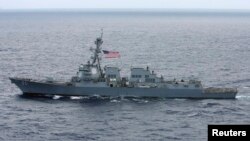The U.S. Navy formally deployed its "Great Green Fleet" on Wednesday, sending warships powered by alternative energy to conduct operations in the Pacific three years after controversy over the price of developing new fuels provoked a fight in Congress.
Navy Secretary Ray Mabus and Agriculture Secretary Tom Vilsack kicked off the deployment in a ceremony at Naval Air Station North Island near San Diego, saying the use of biofuels would improve the Navy's operational flexibility while boosting the U.S. rural economy.
The Navy's focus on developing alternative fuel sources comes despite a 70 percent drop in oil prices since it first tested its Great Green Fleet in exercises in 2012.
Mabus told Reuters in an interview before the ceremony that focusing on energy and energy-saving technology, from fuel-efficient propulsion systems to LED lighting, gave the Navy a military advantage.
An amphibious assault ship like the USS Makin Island, which uses a dual electric-diesel propulsion system, can stay deployed three times longer than a conventionally powered vessel, he said.
"It gives us an edge tactically, it gives us an edge strategically," Mabus said. "It keeps fuel from being used as a weapon against us."
Mabus and Vilsack watched as the destroyer USS William P. Lawrence was refueled at sea with a blend of diesel and biofuel.
The ship is part of a strike group led by the nuclear-powered aircraft carrier USS John C Stennis.
Other ships in the strike group and throughout the Navy will receive the biofuel blend over the next year.
Mabus said deployment of the Great Green Fleet was the next step in a service-wide energy conservation effort that had seen the Navy cut its oil consumption by 15 percent since he took charge in 2009 and the Marine Corps curb its use by 60 percent. Mark Cancian, an analyst at the Center for Strategic and International Studies and former White House budget official, said the Great Green Fleet was more about showing symbolic support for alternative fuels than actual military need.
Republican skepticism
Many congressional Republicans objected three years ago when the Navy won support for defense subsidies to help three private firms build biofuel refineries. With oil now selling around $30 a barrel, that skepticism remains.
"They have not changed their position, which is that these are too expensive and not needed," Cancian said.
The Defense Department uses about 14 million gallons of fuel a day, with the Navy responsible for about a quarter of that, according to figures from the Defense Logistics Agency.
When the Navy first tested biofuel versions of marine diesel and jet fuel in 2012, it spent eye-popping sums for small amounts.
In one case, it paid $424 a gallon for 20,055 gallons of biofuel based on algae oil. To test the Great Green Fleet in the summer of 2012, it spent nearly $27 a gallon for 450,000 gallons of biofuel, later mixed into a 50-50 blend. The $15-per gallon-cost was four times that of conventional fuel.
The fuel for the Great Green Fleet deployment over the next year is a competitively priced blend of 90 percent diesel and 10 percent biofuel made from beef fat, Navy officials said.
A California firm, AltAir Fuels, is contracted to supply 77 million gallons of the fuel between October 1, 2015, and September 30, 2016.
The Navy pays $2.05 a gallon, thanks in part to a subsidy of 15 cents a gallon from the Commodity Credit Corp, a government-owned enterprise that supports farm products.
To boost production of alternative fuels, the Navy has awarded $210 million to help three firms build refineries to make biofuels using woody biomass, municipal waste and used cooking grease and oil. The U.S. Department of Agriculture is providing an additional $161 million in crop supports.
The refineries are expected to begin operations this year, with full production not likely until 2017.






